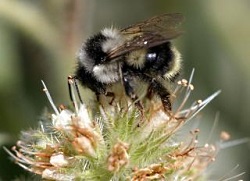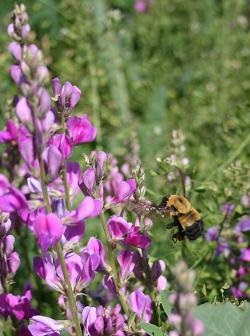
Copyright © 2008 Don Rolfs
This is Linda Kervin for Bridgerland Audubon Society.
When crocuses are pushing through the snow in your garden, you might see another sign of spring: the flights of bees. Other bees may fly in spring, but few are as early or as boisterous as bumble bees. Utah is home to more than a dozen species of bumble bees, all of who belong to the genus Bombus (which in Greek means buzzing). All have a combination of black and yellow markings on their bodies. Some also have orange bands. Unlike honey bees that pass the winter warmly clustered in hives, bumble bees overwinter as solitary queens, dormant under a few inches of loose soil or leaf litter. These queens are quiescent all winter until warming soil beckons their reawakening to start their colony.
From March to May, watch for a behavior called nest searching, when the big, burly queen bumble bees fly low over the ground, stopping often to investigate holes in the earth or in building foundations. Bumble bees nest in small, insulated cavities, such as abandoned rodent burrows or bird houses. Once the queen finds a suitable nest site, she is out and about, foraging for pollen and nectar to provision her offspring. After a few days she will have sufficient food to begin laying eggs. Like all bees, her offspring progress through four life stages: egg, larva, pupa and adult. In just under a month, her daughters develop into adults, each chewing free of its cocoon.

Foraging on Hedysarum
Copyright © 2008 Jamie Strange
These daughters take over foraging and nest construction duties, leaving the queen to remain in her nest and continue to lay eggs and incubate her brood. Workers are often much smaller than their mother, so don’t expect to see many big bumble bees again until autumn, when next year’s queens start the cycle anew, searching for mates and a spot to spend the winter.
This is Linda Kervin for Bridgerland Audubon Society.
Credits:
Photo: Courtesy & Copyright © 2008 Don Rolfs & Jamie Strange
Text: Jamie Strange, USU USDA-ARS Pollinating Insect Research Unit
Additional Reading:
ID a Bumblebee, https://www.ars.usda.gov/Services/docs.htm?docid=10749
Bumblebee Watch, https://www.bumblebeewatch.org/
Bumble Bee Watch is a citizen science project through the partnership of The Xerces Society, the University of Ottawa, Wildlife Preservation Canada, BeeSpotter, The Natural History Museum, London, and the Montreal Insectarium.
